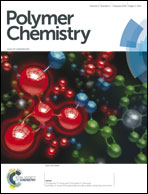Selective O-acyl ring-opening of β-butyrolactone catalyzed by trifluoromethane sulfonic acid: application to the preparation of well-defined block copolymers†
Abstract
A detailed study of β-butyrolactone (β-BL) ring-opening polymerization (ROP) with methane and trifluoromethane sulfonic acids (MSA and HOTf, respectively) is reported. HOTf affords the best results in terms of activity and selectivity, leading to PBL of controlled molecular weights (Mn up to 8200 g mol−1) and narrow distributions (Đ < 1.25). Ring-opening of β-BL occurs selectively via O-acyl bond cleavage and crotonisation reactions do not occur to a significant extent. This leads to hydroxyl terminated PBL that is able to initiate efficiently ROP of ε-caprolactone (ε-CL). Using mono- and dihydroxylated initiators, including macroinitiators, a variety of well-defined block copolymers have been prepared upon successive monomer addition: PBL-b-PCL, PCL-b-PBL-b-PCL, PBL-b-PEG-b-PBL (PEG = polyethylene glycol), PCL-b-PBL-b-PEG-b-PBL-b-PCL and PCL-b-PBL-b-PBD-b-PBL-b-PCL (PBD = polybutadiene). 1H/13C NMR spectroscopy, Size Exclusion Chromatography (SEC) and MALDI-TOF mass spectrometry have been used to ascertain the structure of the obtained polymers.


 Please wait while we load your content...
Please wait while we load your content...